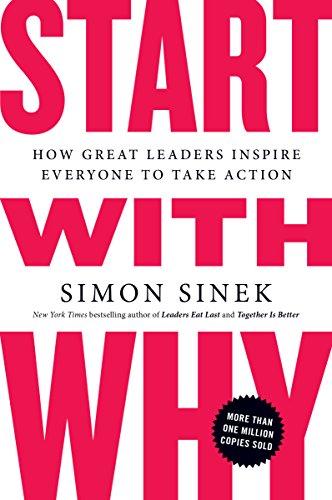

This article is an excerpt from the Shortform summary of "Start With Why" by Simon Sinek. Shortform has the world's best summaries of books you should be reading.
Like this article? Sign up for a free trial here .
Looking for Start With Why discussion questions? How can these exercises help you apply the lessons from Simon Sinek’s book?
Start With Why covers everything you need to know about creating an organization that puts its values at the center of its business. The core concept is simple and straightforward: Great businesses know why they’re doing what they’re doing—and they use that mission as their guiding principle.
Continue reading for discussion questions and exercises inspired by Start With Why.
Discussion Questions for Start With Why
Although there are thousands of successful companies, only a few ever really change the world. The same is true for leaders, too. So what makes these organizations and leaders different from others? They start with WHY. In Start With Why, Simon Sinek walks readers through everything they need to know about putting WHY first in their organization. You’ll learn that when you start with WHY, you’ll keep your company on track, have happier employees, more loyal customers, and better products. But more importantly, you’ll inspire others, which is the key to world-changing success.
Here are some Start With Why discussion questions to help you apply Sinek’s advice.
1: Learn to Identify the WHY
Now that you’ve had a brief introduction to why a person, movement, or company’s WHY is important, let’s think of some other examples.
- We’ve seen three examples of people and companies that start with WHY, i.e. a core idea that motivates them and inspires others. Can you think of another example of a person, movement, or company that starts with WHY? What is their WHY?
- Now let’s think a little bit more about the WHY and its function. For the company or person you identified above, list at least two ways their WHY sets them apart from their competition. (Some reasons might be loyal employees, a world-changing vision, or radical authenticity.)
2: Uncover Your Own Assumptions
Do you let assumptions guide your decisions?
- Think of a time when you made a decision that didn’t quite work out. What were some of the assumptions you had that led you to that choice?
- Now, pretend you have a time machine. Knowing what you know now, what information would you give your past self to change the outcome of that decision?
- Keeping this thought experiment in mind, what are some things you can do to help make sure you’re not making decisions based on false assumptions?
3: Apply The Golden Circle to Your Organization
How can you start applying The Golden Circle to what you do?
- Think about your business or company. What is your WHY?
- Now, take a step back and look at how your company operates. What changes could you make to your company that would help put your WHY first?
4: Trust Your Gut
When has your gut triumphed over your rational brain?
- Think about a time when your gut instinct triumphed over the more logical, rational choice when making a purchase. What was the outcome? How would the outcome have changed if you went with your neocortex (or rational brain) instead?
- Brainstorm at least three ways someone who overthinks decisions might become more comfortable trusting their gut. After all, everyone needs practice to master a new skill!
5: Learn to Use the Three Principles
Is your business operating with a balanced circle in mind?
- Now that you know your organization’s WHY, it’s time to apply the three principles of The Golden Circle. Do you think your company clearly and consistently articulates its WHY? Why or why not?
- It takes discipline to start with WHY, which involves articulating your values as verbs or actions. List two of your organization’s values below, then rephrase them as actions. (For example, if one of your company’s values is “honesty,” you can rephrase it as “do the right thing.”)
6: How You Can Earn Others’ Trust
How can we earn the trust of those around us?
- Think about the people in your life. Who do you trust the most, and what makes you trust them? (We know that trust is in the limbic brain and we’re asking you to use your
- neocortex—but do your best!)
- Now, think of a company you trust and list the things that make you trust it.
- Take a look at both of your lists. What are the similarities and differences? And what does that tell you about how companies can build trust?
7: Get to Know Tipping Points
Are you creating effective tipping points?
- In your own words, explain how The Law of Diffusion helps companies find mass market success.
- Go back and look at the five populations talked about in this chapter. Which products or services make you an early adopter? What categories make you fall into the late majority or laggard population? (As an example: we’re early adopters of consumer technology, but we fall into the late majority when it comes to cars!)
- Does your business currently aim for bringing passionate early adopters on board, or are they stuck marketing to the masses? If they’re aiming for the wrong group, brainstorm ways you could start to shift your focus to the right audience.
8: Explore How WHY and HOW Work Together
How do WHYs and HOWs work together to make great things happen?
- Strong relationships between WHYs and HOWs are key to creating world-changing organizations. What is it about this combination that creates such powerful, compelling companies?
- How can you use The Golden Circle megaphone to help amplify your company’s WHY in your current role?
9: How to Leverage the Power of Symbols
How can you use the power of symbolism in your own organization?
- What are one or two of the most powerful symbols in your life? (These can be anything: a lucky penny, a concert ticket, your favorite hat, etc.) What do these symbols mean to you?
- This chapter talks about The Celery Test to determine what decisions align with your WHY and which don’t. Obviously, not all companies are health food companies like the one in our example, though! What are some of the key elements of your WHY that can be used as benchmarks for your own Celery Test?
10: Stay Connected to WHY
How can you prevent success from affecting your WHY?
- Sinek explains that some of the most successful business people in the world don’t feel successful. Do you feel successful? Why or why not?
- How do you think starting with WHY might make you feel more successful on a daily basis? (Use your imagination here—we’re dreaming about what’s possible!)
- Brainstorm three practical ways you can stay focused on your WHY as your success grows. Some ideas might include allocating time to do some on-the-ground sales as part of your WHAT team and/or incorporating journaling about your WHY into your morning routine. The sky’s the limit!
11: Your Journey to WHY
Let’s explore your own personal journey to WHY.
- Earlier in this guide, we asked you to think about your WHY. Now that you’ve read most of this book and seen Sinek’s own journey, revisit your earlier answer. In what areas of your life are you already starting with WHY? (These can be personal, professional, or otherwise.)
- Now, in what areas of your life aren’t you starting with WHY? Next to each area, write a few words explaining what’s preventing you from starting with WHY.
- Finally, pick one of the areas you identified in the previous response. Now it’s time to start putting together an action plan! What is one short-term action you can take tomorrow to start shifting your focus from WHAT/HOW to WHY? What’s an action you can start next month? What’s an action you’d like to take by the end of the year?
12: Learn to be a True Leader
How do competition and leadership go together?
- In the last two chapters, Sinek introduces his final two concepts: competition and true leadership. How do these two concepts compliment each other?
- What makes a true leader different from others who run companies?
- What is one element of true leadership that you can start working on developing in your own life? Brainstorm a few actions you can start taking to begin inspiring others.
———End of Preview———

Like what you just read? Read the rest of the world's best summary of "Start With Why" at Shortform . Learn the book's critical concepts in 20 minutes or less .
Here's what you'll find in our full Start With Why summary :
- What Steve Jobs did right compared to every other business leader
- How to define your organization's WHY
- How to help your organization avoid losing its edge as it succeeds







I signed up for a free trial with short form and I can’t access the article I would like. It is by Hannah Aster and is Start with Why discussion questions. How can I find the full article?